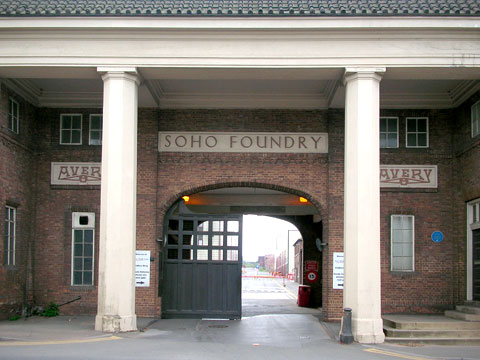Sandwell wants to get shut of historic gates.
Apparently Sandwell council will be pleased to see the famous Grade II Henry Pooley Gates held at the Avery Museum at Soho Foundry (part of the “Silicon Valley of the 18th century“) returned to Liverpool. Above is a shot of the Gatehouse at the Soho Foundry – the Pooley gates can be seen if you go here. The Liverpool Daily Post reports:
The city council has been mired in negotiations with Sandwell Council and English Heritage for years. The major sticking point is getting Grade II building consent to remove them.
Current owners Avery Weigh-Tronnix are understood to approve the deal, leaving the onus on the two councils to agree terms with English Heritage.
Mr Muies, a former seaman who set sail on board the Regent Royal from the Dingle jetty in 1955, said: “People from around the world will come to see them in their original setting because so many of our seamen and women have emigrated and will want to see them back.”
The deal would cost between £35,000 and £40,000, and Sandwell has urged Liverpool to make contact.
So, it seems the whole deal hinges on English Heritage.




I’ve travelled to see The Gates a few times, the Liverpool people and beyond are in for a real treat
People in Liverpool are absolutely delighted to see the gates being returned to the city. Along with the Albert Dock, they are a real link with our past. The Sailors Home in Canning Place was, for over a century, at the heart of Liverpool’s sailortown and was the stuff of legend. To have the gates back, almost where they originally stood will be a wonderful moment for mine and other Liverpool families. My father, grandfather and great-grandfather, all merchant seamen, will have passed through them many times. Many thanks to Sandwell Council and everyone who has made the move possible.
Hi.. I am thinking of doing something on this on Sunday on BBC WM’s Carl Chinn Show.. any suggestions?
Ed
Some of the people in the other comments might be worth trying to find.
There is more good news for fans of The Liverpool Sailors’ Home.
As part of the redevelopment of the site of St Thomas’s Church on Paradise Street by Grosvenor, the site has now been laid out as a memorial garden to all those who are buried there including Joseph Williamson.
The centre piece of the garden is a carved stone replica of the Liver Bird which once adorned the Sailors Home on Paradise Street and which was temporarily stored at the Williamson Tunnels Heritage Centre during the construction of Liverpool One.
It is very good news that in addition to the replica, the original Liverbird is to feature in the Museum of Liverpool when it opens in 2011.
If you want to see ironwork from the Liverpool Sailors’ Home in Liverpool today why not have a walk over to the Malmaison Hotel on Princes Dock?
These curved panels, salvaged in 1974, spent many years in Audlem, Cheshire before returning to their Liverpool home.
And don’t worry, they are just in the entrance so you don’t have to book a room to see them.
If you are visiting North Wales, Clough Williams-Ellis used the Mermaid panels from the home in a few of his buildings in the area, not just Portmeirion.
There’s now new activity regarding these Gates, since the introduction of a new Labour administration, led by an ex merchant seaman, they have now assigned a budget, this is fantastic news as they have also identified a site. These gates have been wonderfully looked after by Sandwell/Avery, but if you wouldn’t mind please send them home. xxx
I have been researching the history of the Liverpool Sailors’ Home for nearly 20 years. It should be remembered that the gates were removed to Birmingham in 1951 so very few people in Liverpool can remember them. It should also be pointed out that that during their time at the Home the main doors of the gates regularly fell off their rails, damaging the ironwork and killing the wife of the doorkeeper in the 1850s and a policeman in the early1900s.
As for copying the gates, sections of the ironwork from the Sailors’ Home have been displayed at the Ironbridge Museum and I have made enquiries about having cast made at their own foundry. It would be possible to produce replica gates from the original (The result would be slightly smaller than the original due to the casting process) or from newly-made patterns but this would be expensive and require sponsorship as Liverpool City Council will not pay for this project out of public funds.
Note also that the statue of the Liverbird, that stood above the gates was rescued from the Sailors’ Home site before the construction of the new John Lewis HQ, has still not found a permanent home in the city and is presumably in storage, like the tonnes of ironwork rescued from the Home before its’ destruction in 1974 and which is unlikely ever to go on public display.
My point here is that there is a great deal to be taken into consideration about these gates and the status quo might not be as bad as it appears. It should also be remembered The Liverpool Sailors’ Home is still a registered charity operating in Liverpool and they might have an opinion on the matter.
Thanks for the information Stephen.
why not from the existing gates make a mould from them and have another pair cast?Keep both parties happy?
Stunningly simple! (wonder why not – any ideas folks?)
Sandwell Council claim they’re “not at risk”. This is not true. The gates are rusting away.
http://www.flickr.com/photos/liverpoolpictorial/sets/72157622252902097/
Henry Pooley cast these Gates in Liverpool, John Cunningham designed them.
These Gates are the last remnant of the Liverpool Sailors Home built circa 1846. The Gates have a real nautical theme including dolphins, sextants and ships wheels, they are crowned by the famous Liverpool Liver Bird, 70 years older than the two which stand on the Liver Buildings.
It is without doubt, due to the diligence and generousity of Avery, that these Gates would have been lost forever, because Liverpool has been rather careless with its historical artefacts.
However Liverpool is now appreciating what it is and what it was, and for Sandwell to return these Sailors Gates, to be installed into a memorial garden in the heart of Liverpool for all to admire, would be seen as a grand gesture.
Liverpool wants the gates back. Sandwell wants them to stay at the Foundry with a plan to apply to Lottery for major site restoration. V.much long term.
In that case, this photo is more apt. They are somewhere within the Foundry, probably to the left at the end of the row of worker’s houses. At a guess, I’d say they were salvaged by Avery when it closed down the Poole foundry in 1931. Postdating the Boulton era by some decades. We can be thankful they weren’t melted down for wartime use, and it does seem fitting that they go back home. With an acknowledgement to the industrialists and ironworkers of Smethwick who recognised their beauty and cared for them all these years.
I thinks this explains things a bot better, plus images of the actual gates:
http://www.liverpoolmonuments.co.uk/gates/pooley12.html
Thanks for the comment and the questions. I was looking for those answers myself, but couldn’t be sure. I have a vague memory from a visit that the gates are inside the main complex – beyond the gates show above.
I used that image because it was the closest I could find. It may however be misleading (or maybe not) The blue plaque refers to the gates.
Sorry I can’t help anymore than that.
This is interesting and peculiar, mainly because so little information is provided in the Daily Post story. What exactly are the gates? Are they the two columns, the metal grill under the arch, or the whole building?
What do Friends of Black Patch Park say about it? How long have the gates been in place? Are they now part of the Boulton & Watt legacy?
These and other questions deserve answers before anyone does more asset-stripping of the Black Patch.